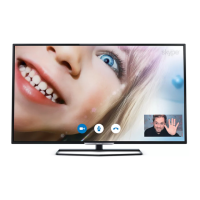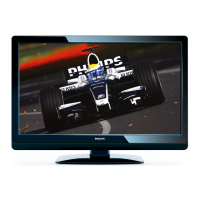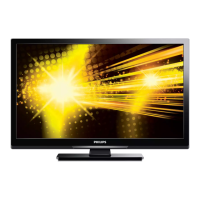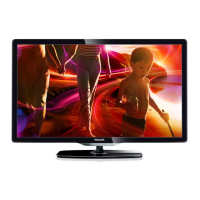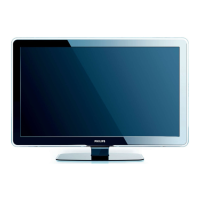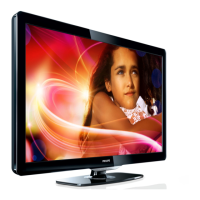Do you have a question about the Philips 32PFS6908 and is the answer not in the manual?
Details on Home screen sections: Highlights, Favorite Apps, Live TV, and YouTube/Netflix.
How to access settings and TV Guide from the Home screen.
How to find TV model/serial number and register.
Accessing TV information, 'How to' guides, and diagnose tools.
Running diagnostic tests for TV condition and settings.
Overview of remote control buttons and their functions.
Importance of reading safety instructions before TV use.
Tips for optimal TV placement and wall mounting.
Instructions for connecting the power cable and turning on the TV.
General advice on connecting devices and cable quality.
Connecting an antenna for DVB-T/C signals.
Connecting a satellite F-type connector.
Connecting video devices via HDMI and copy protection.
Opening and navigating the sources menu to select devices.
How to rename connected devices for easier identification.
Watching channels, using channel lists, and understanding channel icons.
Manual and automatic installation of channels via Antenna/Cable.
Selecting, searching, locking, and removing channels from lists.
Creating, editing, reordering, and linking favorite lists with TV Guide.
Using Teletext features, including subtitles and T.O.P. Text.
Options for Teletext like freezing pages, dual screen, and setup.
Information on viewing current and scheduled TV programs.
Opening, navigating, and tuning to programs via TV Guide.
Overview of Freeview Play features and requirements.
Steps to open and navigate Freeview Play.
Using the TV Guide within the Freeview Play interface.
Viewing media files from a USB drive.
Accessing media files from a network-connected computer or NAS.
Viewing photos, including slideshows and photo options.
Accessing quick menus and frequently used settings.
Overview of the TV's comprehensive settings menu.
Adjusting Super Resolution, Picture Clean, and Format.
Applying picture settings from initial setup or presets.
Adjusting height speaker movement for audio systems.
Selecting preferred sound stage for immersive audio.
Adjusting auto volume and delta volume for better sound.
Configuring digital audio output format for HDMI and optical.
Setting the TV's location mode (Home/Shop) and its effects.
Configuring shop mode features like demos and banners.
Managing demo videos for shop mode.
Resetting all TV settings and performing a full reinstallation.
Connecting the TV to a home network for internet access.
Steps for establishing a wired or wireless network connection.
Viewing current network settings and configurations.
Initial setup and configuration for Smart TV services.
Browsing, sorting, and installing applications from the App store.
Selecting Ambilight styles like Follow Video, Audio, or Colour.
Setting a custom static colour for Ambilight.
Using Ambisleep to simulate sunset for relaxation before sleep.
Overview of Alexa voice control capabilities and requirements.
Steps for setting up and using Alexa voice commands on the TV.
Instructions for updating TV software via internet or USB.
Viewing the current TV software version.
Enabling automatic software updates for the TV.
Displaying a list of past software update versions.
Information on the TV's energy efficiency class and consumption.
The EPREL registration number for the product.
Instructions for proper disposal of the TV and batteries.
Declaration of the TV's compliance with UK regulations.
Details on power, ambient temp, aerial, satellite, and tuner specs.
Screen resolution, input resolutions, sound, and multimedia capabilities.
General troubleshooting advice and where to find help.
Steps to resolve issues when the TV does not switch on.
Troubleshooting remote control response issues.
Solutions for problems finding digital channels or missing channels.
Important safety instructions for using the TV and general warnings.
Hazards like electric shock, fire, injury, stability, and batteries.
Information on open source software used in the TV.
Details on open source licenses applicable to the software.
| AC input voltage | 220 - 240 V |
|---|---|
| AC input frequency | 50 - 60 Hz |
| Energy efficiency scale | A to G |
| Power consumption (standby) | 0.3 W |
| Power consumption (typical) | - W |
| Screen shape | Flat |
| Response time | - ms |
| Display diagonal | 32 \ |
| Display brightness | - cd/m² |
| Display technology | LED |
| Native aspect ratio | - |
| Native refresh rate | 60 Hz |
| Supported video modes | 576p, 720p |
| Display diagonal (metric) | 80 cm |
| Supported graphics resolutions | 640 x 480 (VGA), 1366 x 768, 1920 x 1080 (HD 1080) |
| Sound modes | AI Sound |
| Audio decoders | Dolby Digital, Dolby Atmos, Dolby MS12 |
| RMS rated power | 12 W |
| Number of speakers | 2 |
| HDMI ports quantity | 3 |
| USB 2.0 ports quantity | USB 2.0 ports have a data transmission speed of 480 Mbps, and are backwards compatible with USB 1.1 ports. You can connect all kinds of peripheral devices to them. |
| Audio Return Channel (ARC) | Yes |
| Ethernet LAN (RJ-45) ports | 1 |
| Package type | Box |
| Package depth | 150 mm |
| Package width | 848 mm |
| Package height | 520 mm |
| Package weight | 6700 g |
| Teletext standards | Hyper-text |
| Audio formats supported | AAC, FLAC, MP3, WAV, WMA, WMA-PRO |
| Image formats supported | BMP, GIF, HEIF, JPEG, PNG |
| Video formats supported | AVI, HEVC/H.265, MKV, MPEG1, MPEG2, MPEG4, VP9 |
| Subtitle formats supported | ASS, SMI, SRT, SSA, SUB, TXT |
| High Dynamic Range (HDR) technology | High Dynamic Range 10 (HDR10), Hybrid Log-Gamma (HLG) |
| Tuner type | Analog & digital |
| Analog signal format system | PAL, SECAM |
| Digital signal format system | DVB-C, DVB-S, DVB-S2, DVB-T, DVB-T2, DVB-T2 HD |
| Video apps | Amazon Prime Video, Netflix, YouTube |
| Programming period | 8 day(s) |
| Wi-Fi standards | Wi-Fi 4 (802.11n) |
| Stand type | Legs stand |
| Stand color | Gray |
| Product color | Anthracite, Grey |
| Panel mounting interface | 100 x 100 mm |
| Cables included | AC |
| Battery type | AAA |
| Ambient lighting type | 3-sided |
| Stand width | 616 mm |
|---|---|
| Depth (with stand) | 177 mm |
| Height (with stand) | 451 mm |
| Weight (with stand) | 4600 g |
| Depth (without stand) | 87 mm |
| Width (without stand) | 728 mm |
| Height (without stand) | 433 mm |
| Weight (without stand) | 4500 g |
